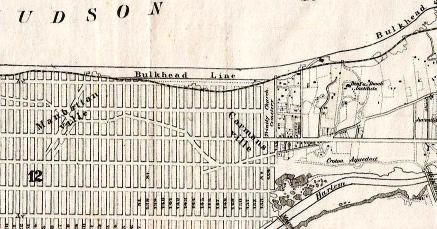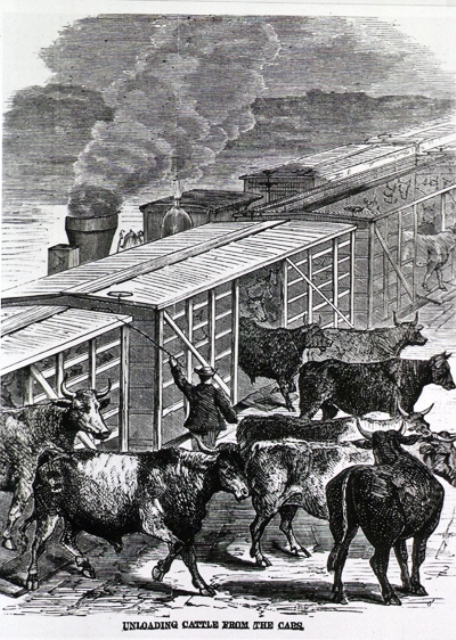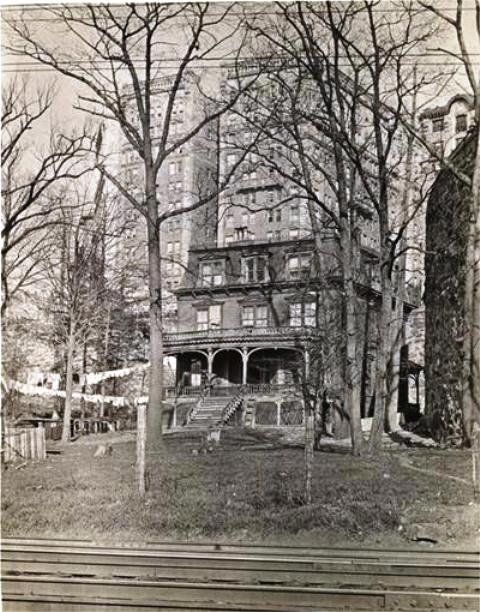6
The Running of the Bulls is a practice that involves voluntarily running in front of a small group of cattle that has been let loose on a fenced-off part of the town’s streets. The most famous running of the bulls takes place during the eight-day festival of Sanfermines in Pamplona, Spain. Every year, about 250 participants receive minor injuries from falls, while a few unlucky people are gored by the bulls’ horns.
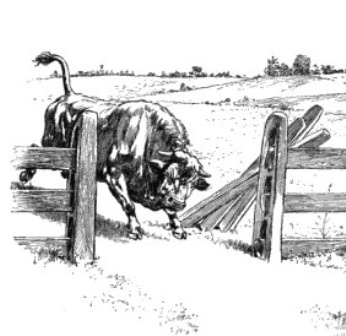
The flimsy fencing around the cattle pens at the Manhattanville train station could not hold back a determined bull.
For residents of New York City’s Manhattanville, Washington Heights, and Carmansville, running of the bulls was almost a weekly occurrence in the 1800s. But for these poor folks, participation was not voluntary.
Where in the World Is Carmansville?
Named after its founder, Richard Francis Carman, Carmansville was a small 19th-century village that encompassed the land between Broadway and the Hudson River from 145th to 158th streets. Today we call this area Hamilton Heights.
Born in New York in 1801, Richard Carman was a wealthy contractor who learned carpentry and construction while making packing boxes for merchants. Following the Great Fire of December 1835, in which about 600 buildings were destroyed in lower Manhattan, he won numerous building contracts and began using his new wealth to deal in speculative real estate investing.
On October 1, 1841, Carman purchased a portion of the former John Watkins – John Maunsell farm from the New York Bowery Fire Insurance Company at a foreclosure auction. He absorbed this land, which encompassed from 152nd to 158th Street, into Carmansville, a small working-class village he was already developing between 152nd Street and 155th Street. A year later, while serving as a New York City Alderman, he sold 24 acres of this land to Trinity Church for a cemetery (the only active burial ground in Manhattan today).

On the same day Carman purchased his acreage, John James Audubon, the renowned ornithologist and painter, bought an adjacent 14 acres of woodlands for his own estate (located at present-day 156th Street and Riverside Drive). He called it Minnie’s Land in honor of his wife, Lucy Bakewell (Minnie was a Scottish endearment for “mother”). The property was originally a working farm with gardens, orchards, and livestock. It featured a stream just about where 157th Street is now, rocky outcroppings, and dense woodlands of oak, elm, and hemlocks. After Audubon’s death in 1851, Lucy and her sons, Victor and John, built and rented about 10 houses on their property. Residents called the neighborhood Audubon Park.
Over the years, the small village of Carmansville built up around the train station for the Hudson River Railway at the foot of 152nd Street. By the 1860s, Carmansville had become a destination for picnickers and other pleasure seekers who would spend the afternoon fishing or catching crabs.

Tracks for the Hudson River Railway at Carmansville in 1885. Carmansville was the first northbound stop on the railway. Museum of the City of New York Collections.
In addition to the railroad station, cemetery, and several churches, the village had a police station (the former 32nd Precinct Mounted Police station house at Amsterdam Avenue and 152nd Street), blacksmith, butcher, and grocer, as well as some modest frame houses and estates. In the 1880s, other businesses sprang up in and around Carmansville, including Major George W. Sauer’s Atalanta Casino and roller skating rink on 8th Avenue and 155th Street.
The Charging of the Bulls
Back to the bulls.
In the 1800s, cattle stampedes were almost a weekly occurrence, especially on Sundays. The steer would scour the boulevards, avenues, and streets, and then charge through the crowds of people going to and returning from church.
A typical street in Carmansville, looking west toward the Hudson River. If you look closely, you can see two goats. Museum of the City of New York Collections
On a typical Sunday, two or more steers would appear on the street, break into a trot, and then full-out charge into the crowd, scattering people in all directions. Neatly dressed women would throw aside their Sabbath decorum and make for the nearest cover at a racing pace. Shawls, hats, and other articles would go flying, no doubt contributing to the animals’ agitation.
The gentlemen, forgetting all gallantry, would perform surprising stunts of agility to avoid harm’s way. The cattle would eventually head into the woods, and few people were actually harmed.
The cattle were escapees from the cattle trains on the Hudson River Railroad. These trains often had as many as 100 cars, each containing 16 heads of cattle. When the trains arrived at the Manhattanville passenger and freight station at 130th Street, the cows were driven into insecure pens by careless drivers. The fencing around the enclosure was composed of decayed boards, which allowed ambitious bulls to escape.
The Church of the Intercession
One of the main churches in Carmansville was the Church of the Intercession, an Episcopal church that held its first services in the parlor of New York merchant John Rowland Morewood’s home in 1846. In 1847, Richard Carman offered the church its first home in a small frame building opposite Trinity Cemetery at the corner of West 154th Street and Tenth Avenue (Amsterdam Avenue).
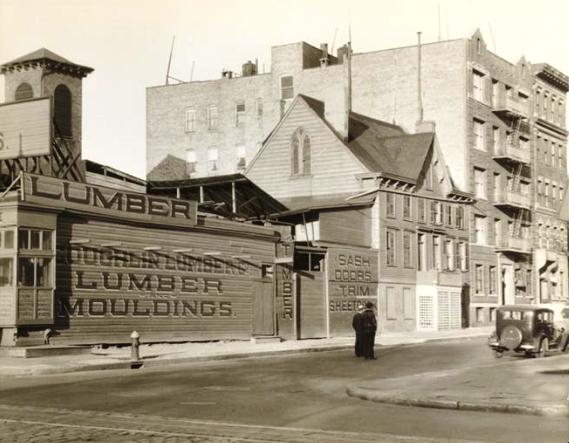
This small frame building (center) on West 154th Street served as Carmansville’s first Episcopal church from 1847 to 1872. The building to the right is still standing. Museum of the City of New York Collections.
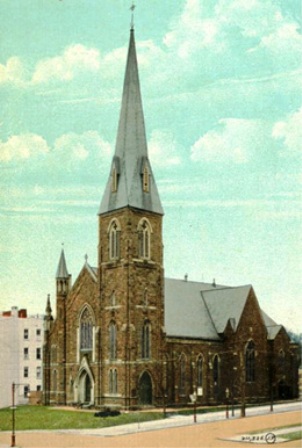
In 1874, when this story takes place, some of the residents of Carmansville would have attended this new Church of the Intercession, which was constructed in 1872 at the corner of 158th Street and Grand Boulevard (now Broadway). In 1906, this building was turned over to the Trinity Church Corporation for use as a Trinity chapel.
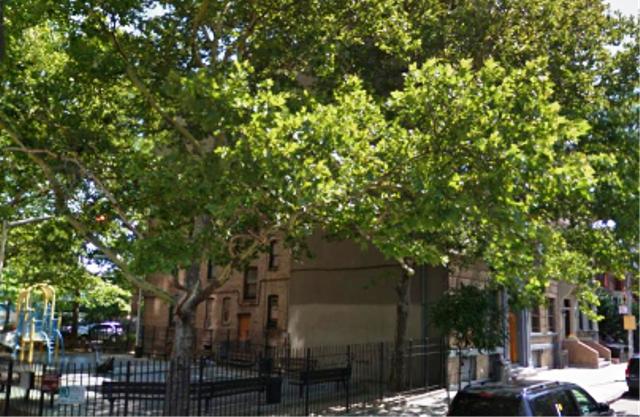
Today you can still see the outline of the old frame church (brown lines) on the side of 429 West 154th St.
Bulls Gone Wild at Audubon Park
The bulls did not limit their stampedes to the main avenues of Carmansville. One time, a herd of about 30 cattle dashed up the train tracks from Manhattanville, turned to the right, and galloped through Audubon Park, destroying everything in their path. One bull broke from the pack and ran toward the river. He jumped into a rowboat moored at the pier, fell into the river, and started swimming across the Hudson River.
The bull reached about halfway across the river but turned around and was eventually lassoed by one of the drovers. Another bull swam across the river to the Jersey shore. It wasn’t until the following evening that the entire herd was captured by police and a group of citizens.

The bulls charged through Audubon Park and destroyed the property of several homes, like this one photographed in 1891.
Following a rash of stampedes, Cornelius “Commodore” Vanderbilt told the public that the stampedes would come to end when the new cattle yards of his New York Central and Hudson River Railroad were completed. The cattle yards, which occupied 60th to 65th Street between 11th Avenue to the North River, opened in January 1875.

In this 1910 photograph of Broadway and 157th Street, we can see the Church of the Intercession (minus the steeple) and some horses. With the new stock yards, residents no longer had to worry about charging bulls. New York Public Library Digital Collections
The Passing of Richard and Mary
“Mr. Carman dispensed his wealth liberally, and his ear was ever open to the appeals of the needy and friendless.”–The New York Times, July 14, 1867
Two years after Richard Carman served as a pall-bearer for his famous Washington Heights neighbor, Madame Eliza Jumel, his wife, Mary Baker Carman, passed away. One month later, in July 1867, Richard died and was laid to rest in Trinity Church Cemetery. His holdings were divided into 257 lots that were subsequently subdivided into smaller land holdings, leading to the development of the residential neighborhood we know today.

